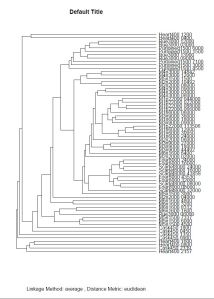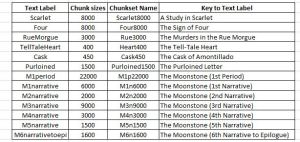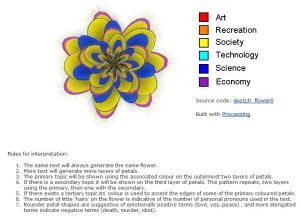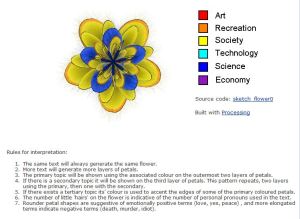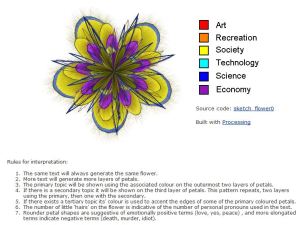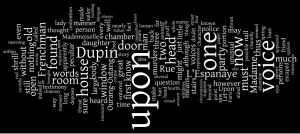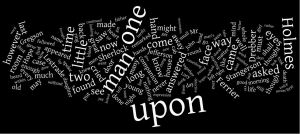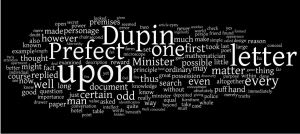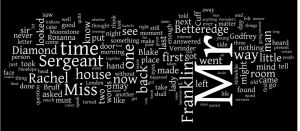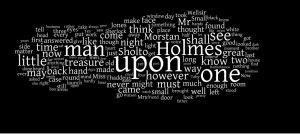Tara’s Results:
I chunked The Moonstone and “The Murders in the Rue Morgue” and found out that The Moonstone is mostly chunked together, and so is “The Murders in the Rue Morgue.” At first I thought I would find more similarities, but it turns out that each text is more similar to itself then each other. The Moonstone is comprised of 8 narratives, plus one more long narrative that opens the novel. It was interesting to find that M6N1600, M5N1500 and Rue3000 had connectiones. From this I depicted that the fifth and sixth narratives of The Moonstone were the most similar to “The Murders in the Rue Morgue.” I decided to focus on these connections. The dendrograms were a starting point for my investigation. They were the jump start towards focusing my attention on the 5th and 6th narratives of The Moonstone. With that observation, I decided to do a literary analysis between The Moonstone (5th and 6th narratives), and the end of “The Murders in the Rue Morgue.” These were my two observations:
1. Britain’s formation of empires during the 19th century was a means of manifesting power over those who were different, and at times weaker. The literary critic and theorist, Edward Said, in his introduction to, Orientalism, writes “how European and U.S. literary and cultural representations, academic disciplines, and public perceptions foster biases against non-Western peoples casting them as oriental Others” (Said 1861), theorizing the effects of British imperialism, and the ways it falsely molded people’s perceptions of Eastern countries. In the fifth narrative of The Moonstone, a young boy is describing what he witnesses, to Sergeant Cuff and Mr. Blake. As he tells his story, he keeps “relating to a dark man” (Collins 467). This relation to a dark man, of different ethnic origin is a continuing theme within Victorian novels and their depiction of “the other” as being dark skinned. Within individual households, like the one Collins creates in The Moonstone, various individuals are presented, who indicate distrust towards India and Indians. Towards the ending of “The Murders in the Rue Morgue,” the witnesses who explain the atrocious sounds they hear at night also depict that they hear foreign voices: A Frenchman’s voice and another one of ethnic origin, supposing it to be Spanish. Collins could have gotten the idea of “the other” from Poe, but it was also an ongoing theme during Imperial Britain’s days. I came to the conclusion that the only difference between Poe’s and Collins’s depiction of “the other” is that the American, Poe, writes a “Spanish” to be the foreigner in his short story, where Collins, the British, writes an, “Indian” to be the foreigner in his novel, since India was one of Britain’s colonies. With the help of the dendrograms, I was able to catch this similarity.
2. My second observation was that the end of “The Murders in the Rue Morgue” is also similar to The Moonstone’s sixth narrative because that is when both the mysteries are uncovered. In “The Murders in the Rue Morgue,” Dupin finds out that the murder was not committed by a human. With a compilation of the abnormal sounds that the witnesses hear, the horrid mutilation of the victims, and the inhuman hair found during the crime scene, Dupin concludes that the suspect is an animal. Dupin also states that the paw print he finds matches that of an Ouran-Outang. Dupin then declares that the owner of the creature is probably a sailor. This connection fascinated me, because it completely matches the suspect in The Moonstone. Godfrey Ablewhite is disguised as a dark man and dressed as a sailor when he steels the Moonstone. Here there is a connection between Collins and Poe, because they both decided to use a sailor as their suspect.
The dendrograms help narrow my focus between Narrative five and six of The Moonstone and “The Murders in the Rue Morgue.” My conclusion form the research I gathered and formulated is that Collins did branch off from some of Poe’s ideas, (based on the above mentioned similarities) since Poe started the mystery genre through his short stories.
Dendrogram I used:

Works Cited
Collins, Wilkie. The Moonstone. New York: Barnes & Noble, Inc, 2005. Print.
Said, Edward W. “Culture and Imperialism.” The Norton Anthology of Theory and Criticism. Ed. Leitch, Vincent B. 2nd ed. New York: NY, 2010. 1888-1904. Print.
Sinead Coleman’s research:
Edgar Allen Poe
“The Purloined Letter” and “The Murders in the Rue Morgue”
Our project was focused on investigating the detective and mystery solving genre of literature. We wanted to concentrate our energy on looking at the first novels and short stories from this genre. This search directed us to Edgar Allen Poe, Willkie Collins and Sir Arthur Conan Doyle. The research we conducted, through the use of dendrograms and other text visualization tools, steered us to conclusion that the texts most similar to each other were those by the same author. I chose to focus my analysis on Poe’s two short stores “The Purloined Letter” and “The Murders in the Rue Morgue”. I thought the most useful research was the dendrogram that showed the stories side by side. My dendrogram raises two questions. (Please note: each text has been divided into five chunks and I have labeled them one through five) The first question: why is chunk two of “The Murders in the Rue Morgue” separate from all other chunks from both stories (ideally shouldn’t part one be next to part two and so on)? The second question presented by the dendrograms: why are chunks one and four of “The Murders in the Rue Morgue” close to each other and then closest next to chunk four of the “The Purloined Letter”?
First, both stories involve the same two main characters. The first is an unnamed narrator who recounts the stories to the reader and audience and the second is the genius yet eccentric detective C. Auguste Dupin. (The character set-up is very similar to Sherlock Holmes and Watson and Poe introduced these characters way before Doyle. This is a commonality within the genre) Dupin is the detective at his best. He is able to solve any mystery by finding the solution that’s always hidden in plain sight. Furthermore Dupin is able to solve the mysteries and crimes through dispassionate analysis. He is able to focus on how the mind works and from there he uses his deductive reasoning skills to figure out the rest. All this intellectual analysis is why he is always able to solve the issue at hand. The use for the unnamed narrator is to present this information to the reader in an interesting and relatable way.
Now for the mysteries they are alike in the sense that Dupin solves them but, the nature of the crime is very different. The crime in the “The Purloined Letter” is in regards to a stolen letter, Dupin must find out where this missing letter is located. The crime in “The Murders in the Rue Morgue” is dark and grizzly, involving a very violent, brutal, and bloody murder. The victims in the story are two females who were murdered in their apartment that was locked from the inside with no sign of an intruder. Dupin, of course, is able to solve both crimes with his aforementioned skills.
Question one presented by the dendrograms can be solved by simply reading chunk two of “The Murders in the Rue Morgue” and then looking at that in relation to the rest of the chunks of both texts. I came to the conclusion that the reason that chunk two is separated from the rest of the texts is because of the subject matter within. Chunk two details the horrible and disgusting murders of the two females. The text describes that a witness heard noises like speaking but weren’t able to ever figure out what was said or an actual ethnicity (but it was like the formulation of the ‘other’ like character that was popular during this imperialistic time because certain ethnicities were mentioned) they said it sounded crazed and alien. This part of the text also explores the shape of the bodies and the wounds inflicted on the corpses as well as where the bodies were located when found after the attack. I believe that this part is unlike the rest of the chunks because the rest of “The Murders in the Rue Morgue” are about the brain and how it works, the relationship between the narrator and Dupin, and the solving of the crime. Not to mention the biggest difference between the texts is in regard to the crimes, one is murder the other is a case of a missing object. The two crimes are extremely different so that is why I believe the dendrogram separated chunk two from “The Murders in the Rue Morgue” from the rest of the chunks.
Question two can also be answered by going back to the chunks and reading them to figure out the similarities. Chunk four of “The Purloined Letter” which is the chunk closest to chunks one and four of “The Murders in the Rue Morgue” is similar because the subject matter is the same. Dupin is talking about how he knew the letter would be in plain sight and not hidden in the nooks and crannies of the Ministers apartment like the Prefect did. He also explains how he knew this to be true. He describes a game that is played by people for fun. This game goes like this, a group of people pull out a map and one person picks something on the map like the name of a city, river, tower, etc. and then the other members of the group try to figure it out with the least amount of incorrect guesses. Dupin says that most people when playing the game choose the thing with the tinniest name; he suspects that people will guess that making it easier to find what the person chose. Dupin suggests then that the best thing to do is to choose the most obvious, largest, longest name that stretches across the map, because that would be the hardest to guess. That is how Dupin knew the missing letter would be out in the open, a place where anyone could see; because that would be the place no one would suspect or check. This type of analytical thinking is how Dupin is able to solve any crime before anyone else. This relates back to the Passages in the “The Murders in the Rue Morgue” because the focus of chunk one and four are very alike. Chunk one is and introduction to Dupin and the narrator as well as a description of how the mind works and processes information not just on the action that takes place. The chunk also details the same things as chunk four about finding clues, talking about how crimes are solved, solving said crimes, coming to specific conclusions, and how the mind develops ideas and conclusions. The other part of chunk four of “The Murders in the Rue Morgue” is the fact that Dupin is actually solving the murder. He discovers the nail and the window, plus the pole near the window, the body in the chimney, the body out in the yard, the type of marks on the body, the clumps of hair, the extreme force that would be needed to commit said crimes, and lastly the murderer’s identity. Dupin identifies the murderer as an orangutan (this is the spelling found on Project Gutenberg: ourang-outang) from East India. Overall there was a legitimate and rational reason for the way the text was chunked in the dendrogram.
These passages illustrate the related and unrelated aspects of the two texts. What I learned from this research was that Poe really created this genre and started a lot of the now typical elements of the detective mystery novels. I realized that a lot of the stories were similar to one another because of the emphasis on the brain and the processing which an important feature of the literature presented.
Research Methodology: The way I read the dendrogram was to first rotate the screen view clockwise so that the information was top to bottom. I then traced the lines horizontally and vertically to find the sections of the text that were similar by location and also looking at the separation of the texts. That is how I was able to figure out my two research questions. From that point I decided to figure out how to label the chunks. I thought that labeling which chunk was first, second, third, and so on would be the easiest. Step two was to figure out how to find the exact part of the text that the chunk was. The way to figure that out was to look at the chunk size and then look at the chunk and if the chunk ended on word 12,000 and the chunk size was 3,000 I knew I would have to subtract 3,000 from 12,000 and read from word 9,000 to 12,000 to figure out the contents of that chunk. This was the process I used to gain this information presented here.

Works Cited
Poe, Edgar A. “The Purloined Letter.” Project Gutenberg. Web
Poe, Edgar A. “The Murders in the Rue Morgue.” Project Gutenberg. Web
Kendra’s Analysis and Continued Research Methodology
Initially, I used the Dendrogram labeled “Everything.” There were three things that stood out to me. Firstly, there are more connections between texts written by the same authors than what we initially supposed. For example, The Sign of Four and A Study in Scarlet are clearly more similar to one another. In the same way, sections of The Moonstone are more similar to itself. Despite this fact, we did notice some similarities between The Moonstone and “The Purloined Letter.” Secondly, most of the similarities that the other texts have with the Moonstone seem to happen during the 6th narrative to the end. Thirdly, reading the dendogram is difficult so I decided create more specific dendrograms, each comparing different permutations of texts.
The two dendrograms I focused on are called:
merge_transpose_MoonstoneRuePurloined15chunks.tsv
merge_transpose_PurloinedMoonstoneFourScarlet.tsv
“PurloinedMoonstoneFourScarlet” and “MoonstoneRuePurloined15chunks.” The former I used to compare just The Moonstone with A Study in Scarlet and The Sign of Four. I used the latter to in my comparison of The Moonstone and “The Purloined Letter.” Using the Dendrograms as a basis, I created various visualizations using Many-Eyes. Please see the following link for these creations: http://www-958.ibm.com/software/data/cognos/manyeyes/users/Lynore. I used both the Phrase Net and the Word Cloud to look for connections and in my analysis.
At first, I focused on the similarity between The Moonstone and “The Purloined Letter.” Using the Dendrogram “MoonstoneRuePurloined15chunks” I noticed that chunks 2760-3220 “The Purloined Letter” is most similar to The Moonstone 6th narrative chunks 4950-5500. After re-reading the tokenized versions I did not notice any striking similarities between the two other than in both cases it is part of the unveiling of the crime. As a result, I ran another test using Many Eyes, specifically the Phrase Net and the Word Cloud of each individual chunksets. Again, this did not provide any viable results, so I broadened the section of the Moonstone, based on similarities in “MoonstoneRuePurloined15chunks” dendrogram and included chunks 4800-6400. By including said chunks, there is a broader context to work with. I would argue that these sections are similar not because it is the resolution of the crime, but the vindication that the written word provides. As the final mystery is in both The Moonstone and “The Purloined Letter” revealed, in both cases through writing.
The final resolution of the mysterious theft of the Moonstone comes from a surprising source: Ezra Jennings. Indeed, Jennings is the linchpin to the solving of the whole mystery. Jennings understands and solves the seemingly supernatural theft not only using scientific and rational thinking, but through his notes and writing. For instance, when discussing how Franklin Blake is to be exonerated:
No! my notes have but one value, looking to the verdict of the world outside. Your innocence is to be vindicated; and they show how it can be done. We must put our conviction to the proof-and You are the man to prove it! (Collins 388)
This passage, although not directly included in the chunkset emphasizes the importance that the written word. Jennings’ journal provides the scientific background for the experiment that Jennings conducts with Blake to prove his innocence. It is an interesting mixture not only of science and rational reasoning, but the careful examination as based on written scientific fact. Moreover, throughout the experiment Ezra Jennings carefully takes notes.
Unlike The Moonstone, the action of “The Purloined Letter” happens through the relatively simple theft and subsequent blackmail. However, in much the same way the Prefect expects Dupin to prove his assertion through producing the missing letter, another piece of writing or text. From the very beginning, Dupin requires a clear description of the missing letter, “…the Prefect, producing a memorandum-book proceeded to read aloud a minute account of the internal, and especially of the external appearance of the missing document” (Poe). Dupin in his brilliance considers not only the external appearance, the criminal who steals the letter. It is this understanding of both that leads Dupin to the solution. He recognizes the letter based on:
…the size alone formed a point of correspondence. But, then, the radicalness of these differences, which was excessive; the dirt; the soiled and torn condition of the paper, so inconsistent with the true methodical habits of D—, and so suggestive of a design to delude the beholder into an idea of the worthlessness of the document; these things (Poe)
Again as with The Moonstone, there is an emphasis on the importance of the written word. Just as Ezra Jennings’ journal establishes Blake’s innocence, so too does Dupin’s retrieving the letter end the blackmail. Moreover, Dupin’s ending replacing the letter with a fake. As Dupin explains, “…letter is not in [the blackmailer’s] possession, he will proceed with his exactions as if it was. Thus will he inevitably commit himself, at once, to his political destruction…” (Poe). It is interesting to note that the role that the letter plays is the opposite as it did with Franklin Blake. In an interesting reversal, for Franklin Blake Jennings’ journal ensures his absolution, whereas the letter causes the blackmailers’ destruction. The role of secrets and the solution of crime in these texts all seem to connect closely to writing.
Here are some samples of the phrase nets I ran. Although not directly cited in my analysis of the text these did inform my perspective.
 This is from The Moonstone.
This is from The Moonstone.
 This is from “The Purloined Letter”
This is from “The Purloined Letter”
 This is from The Sign of Four.
This is from The Sign of Four.
Notice how without the helpful labels, it would be difficult to ascertain which texts these phrase nets came from. This would be a future area that I would be interested in pursuing.
Works Cited
Collins, Wilkie. The Moonstone. Ed. Sandra Kemp. London: Penguin, 1998. Print.
Conan Doyle, Sir Arthur. A Study in Scarlet & The Sign of the Four. Hertfordshire: Wordsworth Editions Limited, 2004. Print.
Murch, A.E. The Development of the Detective Novel. New York: Greenwood, 1958. Print.
The Purloined Letter










